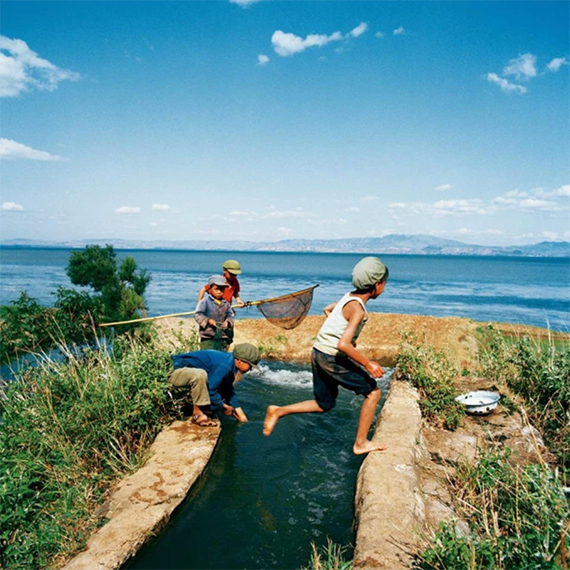
Ryoji Akiyama »
Dear Old Day
Exhibition: 15 Jul – 8 Oct 2023

Three Shadows Photography Art Center
No.155, Caochangdi, Chaoyang District
100015 Beijing
+86-10-64322663
info@threeshadows.cn
threeshadows.cn/
Tue-Sun 10-18
Three Shadows Photography Art Centre, in collaboration with Seisodo, will be presenting Ryoji Akiyama's classic photograph collection “Dear Old Days”. The exhibition will run from July 15 to October 6, 2023. Between 1981 and 1982, Ryoji Akiyama visited China five times, setting foot in Beijing, Shanghai, Guangzhou, Chengdu, Harbin, Guilin, Hohhot, Urumqi, and even Hainan Island, which was closed to foreigners at the time, with the help of the Chinese Photographers Association. He took about 8,000 colour photos with about 700 rolls, from which 116 were selected and published as the album Hello Kids, the first volume met the public in 1983. The works of the upcoming exhibition are from the first volume, as well as the other two volumes compiled and published in recent years under the name Dear Old Days.
In art history, children is often depicted as the epitome of the grown-ups or the symbol of innocence. When viewing works that focus on children, we naturally identify ourselves with the group and the beautiful imagination related to them, and connect ourselves to another time period other than the present. As a result, time seems to be compressed. Within the exhibition space, and the 1980s and the present seem to coexist at the same time. The photographs, traveling from the 1980s to the present, “invite” us to peek into the daily life of those kids, as well as what childhood looked like four decades ago. Thus we are able to not only re-experience our own good old days, but also explore others’. Moreover, there is not only the one-way imagination and observation towards the frame, but also the mutual dialogue, as the universal innocence of the childhood connects the viewers and the characters in the photographer's works.
Re-researching this series also help us discover things hidden in plain sight. In A Short History of Photography, Walter Benjamin puts forward the concept of optical unconscious. He argues that “however skillful the photographer, however carefully he pose his model, the spectator feels an irresistible compulsion to look for the tiny spark of chance, of the here and now, with which reality has, as it were, seared the character in the picture; to find that imperceptible point at which, in the immediacy of that long-past moment, the future so persuasively inserts itself that, looking back, we may rediscover it.” For instance, Ryoji Akiyama took a photo of two kids looking at each other at the entrance of an alley in Beijing, yet it is only years later that the photographer learnt about there might have the hidden connection between the two.
The same can be said to the boy sitting on a bench and studying in the street, the girl in clothes with holes and patches, the one selling fruits at the wet market with his mother, the one tied to the back of a bicycle by his father with a rope, and those helping their parents in the field. Apparently, before the age of abundance, childhood was not necessarily the synonym of happiness and carefreeness, but sometimes hardship and poverty. The world beyond these images can only be grasped through our own speculation and association.
The series has evoked a wave of nostalgia in China, also because of the rarity of colour photos in the 80s. Ryoji Akiyama himself once said that, “Rather than saying my works are great, I think the main reason behind their popularity is that many Chinese have a special affection for the 80s, and the colour photos from that time are very rare.”
One of the trends in Chinese photography in the 1980s was the “documentary turn”. For this period, documentary photography in China was closely related to the country’s socio-political transformation. Most contents reflect the artists' advocate for openness and respect for humanity, discussing serious social issues. Foreign artists such as Kazuo Kitai, Michelangelo Antonioni and Liu Heung Shing, who came to China during the same period, also focused their lenses on the state of life of the general public, and the relationship between people. Ryoji Akiyama, on the contrary, approached the social landscape with a more playful perspective. This is perhaps more relatable and appealing to ordinary spectators, and in the historical sense, it also offers a new narrative of that time with its unique angle.
The exhibition is curated with two sub-themes. The first is the subjects being photographed, i.e. the children themselves. While the original arrangement of the museum space is maintained, different fields are created, connecting the specific campus environment, and producing an echo between the exhibition space and the space in the photos. The second is the social environment of the 1980s, which mainly includes works from “Dear Old Days”, the third album of the series. How people worked and lived, what they wore, and what they did for fun 40 years ago are depicted in these works, complementing the background for the first volume.
With his Rolleiflex and Sakura films, Ryoji Akiyama captured the innocence of Chinese kids back in the 1980s, and behind the seemingly random and spontaneous punctum is the dynamic balance between serendipitous shot and calculated composition. Rather than a pure throwback to that era, we hope the exhibition is an opportunity to refresh our memories, and each spectator can obtain new experiences in life, new connections with others, and new feelings towards the surroundings from it.
Text/Zhang Siyang